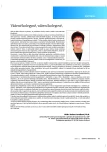Risks of treatment by dabigatran in seniors with chronic kidney desease
Authors:
MUDr. Homolková Slávka; MUDr. Jaroňová Darja; MUDr. Hrnčiariková Dana, Ph.D.
Authors‘ workplace:
III. interní gerontometabolická klinika FN Hradec Králové
Published in:
Geriatrie a Gerontologie 2020, 9, č. 2: 93-96
Category:
Dabigatran u starších pacientů s chronickým onemocněním ledvin představuje zvláštní výzvu. S progresí renální insuficience se zvyšuje účinek dabigatranu, kvůli prodloužené eliminaci stoupá jeho koncentrace v séru. Pacienti starší 75 let navíc vykazují vyšší hladiny léčiva, než mladší nemocní se stejnou dávkou. V geriatrii se často kombinují dva rizikové faktory – věk a renální insuficience. Souběh těchto dvou faktorů může způsobit obtížný odhad antikoagulačního účinku dabigatranu.
Overview
Dabigatran anticoagulation therapy in patients with chronic kidney disease can be challenging. Progress of renal insufficiendy leads to prolonged drug elimination and thus higher levels of dabigatran serum. In addition, patients over 75 years of age have higher levels of the drug in serum than younger patients using the same dose. In geriatrics, two risks factors are often combined – renal insufficiency and higher age. This combination may be difficult to estimate the anticoagulant effect of dabigatran.
Standard test to monitor dabigatran therapy is not available at the moment. howewer, activated thromboplastin time – a routine test that is commonly available – can be used to control adherence and compliance to dabigatran therapy. Frail geriatric patients are in a high risk of rapid dehydration, which corelates with progression of pre-existing renal insufficiency and thus accumulation of dabigatran.
Three case reports are presented, which indicate the need for more frequent inspections, individualization of the dose of this anticoagulant and multidisciplinary cooperation.
Keywords:
bleeding – seniors – dabigatran – chronic kidney diesease
Sources
1. Burdová K. Přímá perorální antikoagulancia. Klin Farmakol Farm. 2015;29(4), 138–143. ISSN 1803-5353
2. Bultas J. Nová perorální antikoagulancia – o čem se nemluví. Kapitoly z kardiologie pro praktické lékaře. 2015;7(2): 47–56. ISSN: 1803–7542.
3. Čihák R, Haman L, Táborský M. The 2018 European Heart Rhythm Association Practical Guide on the use of non-vitamin K antagonist oral anticoagulants in patients with atrial fibrillation. Summary of the document prepared by the Czech Society of Cardiology. Cor et Vasa [online]. 2018, 60(4), e421-e446 [cit. 2020-04-28]. DOI: 10.1016/j.crvasa.2018.05.001. ISSN 00108650. Dostupné z: http://e-coretvasa.cz/doi/10.1016/j.crvasa.2018.05.001.html
4. Veselý J. Nové indikace dabigatran etexilátu. Remedia 2018; 28: 123–126.
5. Anghel L, Sascău R, Trifan A, Zota IM, Stătescu C. Non-Vitamin K Antagonist Oral Anticoagulants and the Gastrointestinal Bleeding Risk in Real-World Studies. J Clin Med 2020; 9(5): E1398. Published 2020 May 9. doi:10.3390/jcm9051398
6. Goldhaber SZ, Schulman S, Eriksson H, et al. Dabigatran versus Warfarin for Acute Venous Thromboembolism in Elderly or Impaired Renal Function Patients: Pooled Analysis of RE-COVER and RE-COVER II. Thrombosis and Haemostasis. 2017 Nov;117(11):2045-2052. DOI: 10.1160/th17-03-0176.
7. Schulman S, Kearon C, Kakkar AK, et al. Dabigatran versus warfarin in the treatment of acute venous thromboembolism. N Engl J Med 2009; 361: 2342–2352.
8. Šinigoj P, Vene N, Košmelj K, Mavri A. Risk of major bleeding in elderly patients with atrial fibrillation on direct oral anticoagulants: real world experience. Int J Clin Pharm. 2020;42(2):445–452. doi:10.1007/s11096-020-01008-1.
9. Bolek T, Samoš M, Škorňová I, et al. Dabigatran Levels in Elderly Patients with Atrial Fibrillation: First Post-Marketing Experiences. Drugs Aging 2018; 35, 539–544. https://doi.org/10.1007/s40266-018-0552-4.
10. Česká společnost pro trombózu a hemostázu [online]. Copyright ©m (cit. 05.04.2020). https://csth.cz/soubory/Doporuceni-pro-bezpecnou-lecbu-NOAC.pdf
11. Vyšetření funkce ledvin: možnosti biochemické laboratoře - Zdraví.Euro.cz. Zdravotnictví a medicína - Zdraví.Euro.cz [online]. Dostupné z: https://zdravi.euro.cz/clanek/postgradualni-medicina/vysetreni-funkce-ledvin-moznosti-biochemicke-laboratore-170714.
12. Kvasnička J, Malíková I. Laboratorní kontrola nových přímých antikoagulancií. Remedia. 2014, 24(2), 108–112. ISSN 0862-8947. Dostupné také z: http://www.remedia.cz/Archiv-rocniku/e.folder.aspx.
13. Butler J, Malan E, Chunilal S, Tran H, Hapgood G (2013). The effect of dabigatran on the activated partial thromboplastin time and thrombin time as determined by the Hemoclot thrombin inhibitor assay in patient plasma samples. Thrombosis and Haemostasis, 110(08), 308–315. doi:10.1160/th13-04-0301.
Labels
Geriatrics General practitioner for adults Orthopaedic prosthetics Hygiene and epidemiology Medical virology Clinical microbiologyArticle was published in
Geriatrics and Gerontology

2020 Issue 2
Most read in this issue
- Frail patients in long term care institutions
- Coronavirus infection within senior people – The immunologist’s view
- Influence of selected factors on evalution of dignity of older person
- Risks of treatment by dabigatran in seniors with chronic kidney desease
